I have written a simple COM object in C# with only one method, which is called GetMac. I can't get it to work. I am trying to access it from a legacy Borland C++ Builder 4 (BCB4) application, which I know is old, and not used much anymore, but I am able to access other COM objects from it fine.
The Borland development machine is running Windows XP, so I make the C# COM object target the .NET 4.0 framework. I copied the DLL and PDB file over from the C# Visual Studio machine to the XP machine. I registered it via the following command:
"%WINDIR%\Microsoft.NET\Framework\v4.0.30319\regasm.exe" TRSDotNetCOM.dll /tlb /nologo /codebase
I am able to instantiate the COM object (class) fine via the following line of code:
Variant TDN = CreateOleObject("TRSDotNetCOM.TRSCOM_Class");
If I change the name string, it doesn't work, so I know I have this part correct.
However, when I try to call the method as follows:
MacV = TDN.OleFunction(funcNameV,counterV,macKeyV);
... I get a runtime exception (unfortunately, there's an issue with BCB4's exception handling for OLE calls, so the only info the debugger gives me is "Exception Occurred").
Since I am able to call other COM objects from the same BCB4 application in the same manner, I don't think the problem is with my C++ code. I think it is an issue with either the C#-created COM DLL, or the registration thereof.
To explore this, I used Microsoft OLE/COM Object Viewer to browse my system for the OLE object. I was able to find my object as "TRSDotNetCOM.TRSCOM_Class", as expected.
I'm brand new at using the OLE/COM Object Viewer, so I hope I am looking at the right things below:
When I expand the class, I see the following:

I right-clicked on _Object and chose "View", then "View Type Info". Then, the pane on the right shows:
[ uuid(65074F7F-63C0-304E-AF0A-D51741CB4A8D), hidden, dual, nonextensible,
custom({0F21F359-AB84-41E8-9A78-36D110E6D2F9}, "System.Object")
] dispinterface _Object {
properties:
methods:
[id(00000000), propget,
custom({54FC8F55-38DE-4703-9C4E-250351302B1C}, "1")]
BSTR ToString();
[id(0x60020001)]
VARIANT_BOOL Equals([in] VARIANT obj);
[id(0x60020002)]
long GetHashCode();
[id(0x60020003)]
_Type* GetType(); };
When I expand the tree on the left, this is what I see:

I do not see my method "GetMac" listed anywhere in there. So, I'm thinking that somehow the method is not visible to COM, or that it's not getting registered via regasm.
Here is the source for the COM object:
using System;
using System.Runtime.InteropServices;
using System.Security.Cryptography;
using System.Text;
namespace TRSDotNetCOM
{
[Guid("80ef9acd-3a75-4fcd-b841-11199d827e8f")]
public interface TRSCOM_Interface
{
[DispId(1)]
string GetMac(string counter, string macKey);
}
// Events interface Database_COMObjectEvents
[Guid("67bd8422-9641-4675-acda-3dfc3c911a07"),
InterfaceType(ComInterfaceType.InterfaceIsIDispatch)]
public interface TRSCOM_Events
{
}
[Guid("854dee72-83a7-4902-ab50-5c7a73a7e17d"),
ClassInterface(ClassInterfaceType.None),
ComVisible(true),
ComSourceInterfaces(typeof(TRSCOM_Events))]
public class TRSCOM_Class : TRSCOM_Interface
{
public TRSCOM_Class()
{
}
[ComVisible(true)]
public string GetMac(string counter, string macKey)
{
// convert counter to bytes
var counterBytes = Encoding.UTF8.GetBytes(counter);
// import AES 128 MAC_KEY
byte[] macKeyBytes = Convert.FromBase64String(macKey);
var hmac = new HMACSHA256(macKeyBytes);
var macBytes = hmac.ComputeHash(counterBytes);
var retval = Convert.ToBase64String(macBytes);
return retval;
}
}
}
I did make sure and go into the project properties and check the "Register for COM interop" checkbox. I also generated a Secure Name file with the "sn" utility, and loaded the file in the Signing section of settings.
So...
1) Am I looking in the correct place in the OLE/COM Object Viewer for my method?
2) If so, why would my method not be visible or not get registered?
3) Any ideas of what else could be wrong?
UPDATE: Here is the updated code with Joe W's and Paulo's suggestions. (It still does not work however)
using System;
using System.Runtime.InteropServices;
using System.Security.Cryptography;
using System.Text;
namespace TRSDotNetCOM
{
[Guid("80ef9acd-3a75-4fcd-b841-11199d827e8f"),
ComVisible(true)]
public interface TRSCOM_Interface
{
[DispId(1)]
string GetMac(string counter, string macKey);
}
// Events interface Database_COMObjectEvents
[Guid("67bd8422-9641-4675-acda-3dfc3c911a07"),
ComImport,
ComVisible(true),
InterfaceType(ComInterfaceType.InterfaceIsIDispatch)]
public interface TRSCOM_Events
{
}
[Guid("854dee72-83a7-4902-ab50-5c7a73a7e17d"),
ClassInterface(ClassInterfaceType.None),
ComDefaultInterface(typeof(TRSCOM_Interface)),
ComVisible(true),
ComSourceInterfaces(typeof(TRSCOM_Events))]
public class TRSCOM_Class : TRSCOM_Interface
{
public TRSCOM_Class()
{
}
public string GetMac(string counter, string macKey)
{
// convert counter to bytes
var counterBytes = Encoding.UTF8.GetBytes(counter);
// import AES 128 MAC_KEY
byte[] macKeyBytes = Convert.FromBase64String(macKey);
var hmac = new HMACSHA256(macKeyBytes);
var macBytes = hmac.ComputeHash(counterBytes);
var retval = Convert.ToBase64String(macBytes);
return retval;
}
}
}